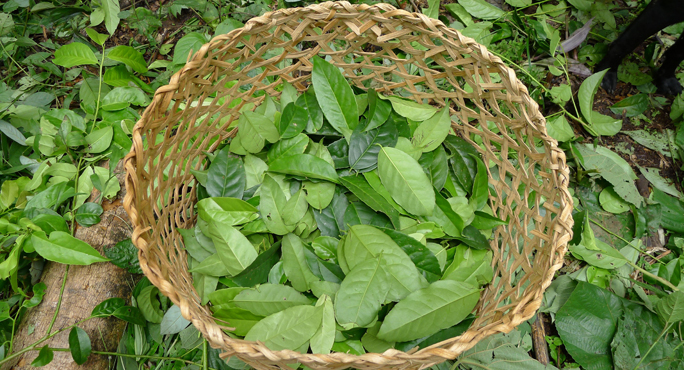Photo by Chris Kilham
Recently I spent time in Napo Province, in the beautiful South American country of Ecuador. I was there to study two plants, one of which is a relatively unknown tea called guayusa. Guayusa enjoys a history of use among some native tribes in Ecuador, notably the Jivaro tribe. Among the Jivaro, the drinking of guayusa is a daily event and a morning ritual.
Historically the Jivaro would rise early, make a fire, boil a pot of guayusa leaves, drink the tea and tell stories. This practice helped to reinforce kinship and community, giving people an opportunity to come together and share stories. Among the Jivaro, guayusa is known as “Night Watchman,” because it helps to keep you awake.
Guayusa (Ilex guayusa) is a small tree that grows in the Ecuadorian rainforest, and whose leaves are rich in naturally-occurring caffeine. Guayusa contains less caffeine per cup than coffee, but more caffeine per cup than green tea or yerba mate’. Guayusa possesses a mild flavor, and a pleasant aroma.
One morning very early in Ecuador, I set out with about a dozen people from the small town of Archidona, out into the countryside. We arrived at a trail head leading into the forest by about 3:30 a.m., and set out from there to a tiny village farther into the woods. After about half an hour of hiking in the dark, we came to the Wayra Churi village, where about ten native people were sitting around a fire. We joined them, and watched as a woman placed leaves into a clay pot that sat on the fire. After the leaves cooked for several minutes, the woman scooped some tea out into a gourd, and passed that out. She did this with one gourd after another, until we all had some guayusa to drink. In the chill of the early Amazon morning, the hot liquid felt very good. As the sun’s first light scratched at the dark of night, we sat around the fire, telling stories, and talking about the invigorating effects of the guayusa.
Guayusa is unusual. On the one hand, it contains caffeine, and so is useful in helping to maintain wakefulness. On the other hand, guayusa also contains an ample supply of L-theanine, an amino acid that imparts a feeling of pleasant tranquility. The combination of the two creates a light stimulation, but very smooth. Basically in guayusa you have a stimulant without ragged edges.
During the course of several days in Ecuador, I was able to see and participate in the planting of guayusa seedlings, harvesting guayusa leaves, and spending time with people from a project called Runa, who have organized guayusa growers and harvesters into a community. Using certified organic agriculture and fair wages, the Runa project is providing economic opportunity to native people who typically rely on performing day labor to get by. It’s a good model of agriculture performed in a safe, non-toxic way that can actually lead to a decent living for growers.
Guayusa is just in the early stages of making its way in the US. You can find the Runa Guayusa in Whole Foods and some other markets, as the beverage becomes more popular. You can also find Runa - Amazonian Guayusa online. In many ways, guayusa reminds me of the other South American tea, yerba mate’. Several years ago yerba mate’ was little known. But people have become familiar with it, and like the lift. I believe that the same thing will happen with guayusa. The pleasant flavor and smooth stimulation of guayusa make it easy to like.
People like stimulating beverages, including coffee, tea, guarana, cola, cocoa and yerba mate’. All of these beverages contain caffeine, and they give a boost to both body and mind. All of them have played roles in indigenous life throughout history, and all of them are now circulating all over the globe. Guayusa will find its place. It may be a newcomer to the US, but it has been part of native life in South America for a long time. As people discover its smooth lift and get turned on the starting the day with a big cup of guayusa, it is bound to catch on.



